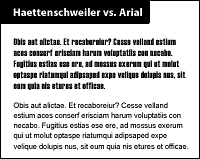September 2010 – April 2016
Leibniz Competitive Funds within the Pact for Research and Innvoation
 According to Cognitive Load Theory (CLT; Sweller, van Merriënboer, & Paas, 1998), multimedia instructional material should be designed in a way that it is easily perceived so that an unnecessary working memory load is prevented, reducing the risk to hamper learning by overloading working memory. This intuitive assumption has recently been challenged by research on “disfluency” in educational settings (Diemand-Yauman, Oppenheimer, & Vaughan, 2011). These authors argue that a certain amount of illegibility – which is termed disfluency - leads to a deeper engagement and processing of the text, resulting in better learning. Accordingly, they showed that harder-to-read fonts (e.g., Haettenschweiler) lead to higher learning outcomes compared to easier-to-read fonts (e.g., Arial). However, the current research on disfluency is restricted to text processing. Whether results from research on disfluency apply to multimedia learning scenarios, where text is accompanied by pictures, and which consequences this may have for CLT is investigated in this project. Moreover, it is investigated which cognitive processes cause the disfluency effect.
According to Cognitive Load Theory (CLT; Sweller, van Merriënboer, & Paas, 1998), multimedia instructional material should be designed in a way that it is easily perceived so that an unnecessary working memory load is prevented, reducing the risk to hamper learning by overloading working memory. This intuitive assumption has recently been challenged by research on “disfluency” in educational settings (Diemand-Yauman, Oppenheimer, & Vaughan, 2011). These authors argue that a certain amount of illegibility – which is termed disfluency - leads to a deeper engagement and processing of the text, resulting in better learning. Accordingly, they showed that harder-to-read fonts (e.g., Haettenschweiler) lead to higher learning outcomes compared to easier-to-read fonts (e.g., Arial). However, the current research on disfluency is restricted to text processing. Whether results from research on disfluency apply to multimedia learning scenarios, where text is accompanied by pictures, and which consequences this may have for CLT is investigated in this project. Moreover, it is investigated which cognitive processes cause the disfluency effect.